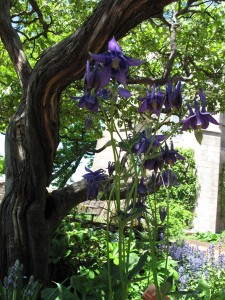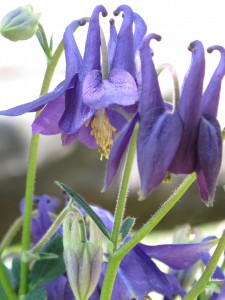Eagle or Dove?
Columbine flowering under a quince tree in Bonnefont garden. Columba is Latin for “dove,” and the flower is named for the fancied resemblance of its nectaries to a circle of doves. The modern botanical name, Aquilegia, also??links the blossom with a bird, but refers to the Latin for eagle, aquila. Both avian associations were current in the Middle Ages. Photographs by Corey Eilhardt
A number of the medieval names for the delightful Aquilegia vulgaris, a member of the Ranunculaceae, or buttercup, family, were suggested by the resemblance of the flower’s nectaries to a circle of birds, whose wings extend downward from their incurving necks, as if they were feeding from a dish. According to Albertus Magnus the name aquilegia was taken from aquila, the Latin for “eagle.” While Richard Mabey and others presume that the identification with the eagle was made on the basis of the “winged” nectaries, Maude Grieve claims that the spurs of the flowers were thought to resemble the raptor’s talons, although she provides no historical source for this identification. Hildegard of Bingen referred to the columbine as agleya. (For more on Hildegard of Bingen, see “Mutter Natur” (October 15, 2010). The modern German name for the columbine is akelei, and the plant is still known in Italy as aquilina.
In both French and English, the plant is commonly known as “columbine,” in keeping with the medieval columbina from the Latin for dove or pigeon. The??herbal of Pseudo-Apuleius attributes the name not to the form, but to the color of the flower, which is said to resemble that of the columba.
???Deirdre Larkin
Sources:
Anderson, Frank J., ed. “Herbals through 1500,” The Illustrated Bartsch, Vol. 90. New York: Abaris, 1984.
Bedevian, Armenag K. Illustrated Polyglottic Dictionary of Plant Names in Latin, Arabic, Armenian, English, French, German, Italian and Turkish Languages. Cairo: Argus & Papazian Presses, 1936.
Grieve, Maude. A Modern Herbal. 1931. Reprint: New York: Dover Publications, 1971.
Freeman, Margaret B. The Unicorn Tapestries. New York: E. P. Dutton, Inc., 1956.
Mabey, Richard. Flora Brittanica. London: Chatto & Windus, 1996.
Throop, Priscilla, transl. Hildegard von Bingen’s Physica: The Complete English Translation of Her Classic Work on Health and Healing. Rochester, VT: Healing Arts Press, 1998.


